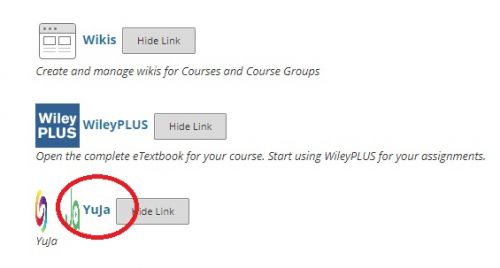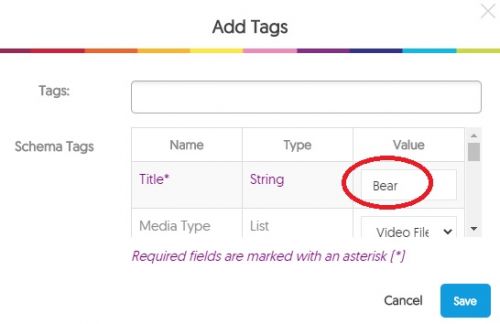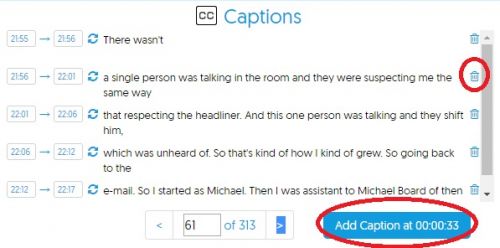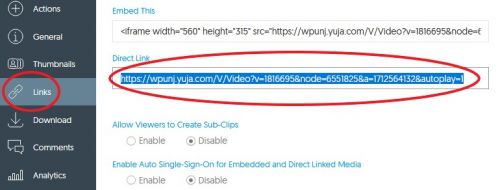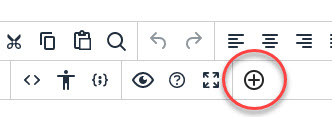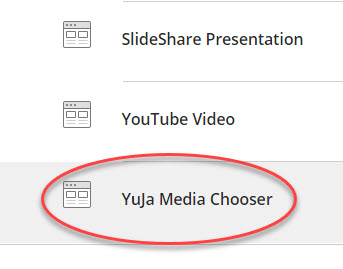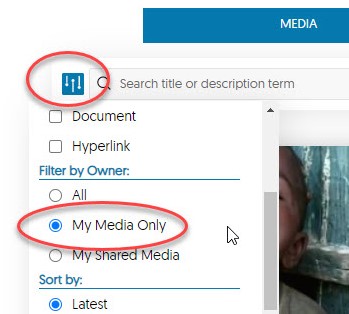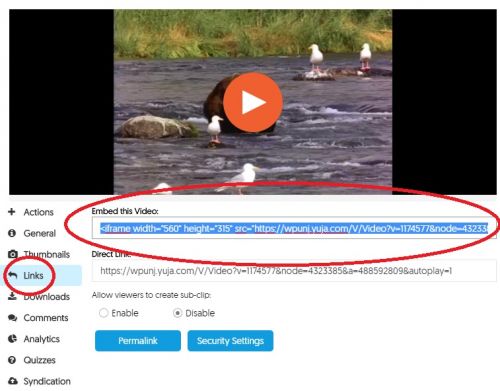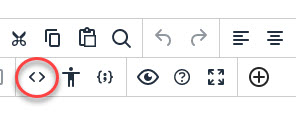YuJa

YuJa [1] (YuJa) is an enterprise media platform that facilitates online hosting, playback, and user management of digital media, as well as lecture capture, live streaming, social learning, video conferencing, and video test proctoring solutions. It encompasses a front-end website, referred to colloquially as WPU's YuJa zone, which displays media that has been made available to WPU faculty and students for pedagogical purposes, and back-end account capabilities through which WPU members may upload and manage user-specific media content after signing in.
William Paterson University began using YuJa at the end of April 2020 to replace Illumira (formerly known as NJVid).
Overview
Signing into Your YuJa Account
All William Paterson University faculty, staff and students are granted YuJa accounts. YuJa has three classifications of user privileges: "Student," "Instructor," and "Administrator." WPU faculty are given "Instructor" status. An individual may access his/her YuJa account either through Blackboard or through WPU's YuJa zone. YuJa accounts are not tied to particular Blackboard course shells. As a result, a faculty member can sign into his/her YuJa account from any course shell in Blackboard and still gain access to all content in his/her YuJa account. Similarly, a user can retrieve any content that he/she places into his/her YuJa account irrespective of where he/she signs into his/her YuJa account from, including via any Blackboard course shell or www.wpunj.edu/yuja.
If you are a WPU faculty member who is signing into YuJa for the first time, we recommend you do so via Blackboard so that YuJa will recognize you as a faculty member.
Signing in Through Blackboard
1. Sign into Blackboard and navigate to the course in which you intend to use YuJa.
2. Click “Tools” from the left-hand menu.
3. Click on “YuJa.”
4. If you are a faculty member who is accessing YuJa via Blackboard for the first time, you might receive an automated email that confirms your account or course has been created.
Signing in Through WPconnect or WPU's YuJa Zone
1. Go to WPconnect, logon, and search for the YuJa link or click on the YuJa icon under the Apps display.
2. You may also go directly to www.wpunj.edu/yuja and enter your William Paterson username and password.
Creating a Recording
You can use YuJa to record yourself in front of a webcam, video capture your computer screen, and/or simply record your voice.
1. Sign into YuJa and click “Create Recording” from the top menu
2. If this is your first time recording on a University-imaged computer, please install the YuJa Software Capture app via Software Center. If this is your first time recording on an off-network home device, click the "Download" button and double-click the installer. In all other cases, click “Start.” The Software Capture app will open.
3. Enter a title and description for your recording, and click the folder icon at the right to specify its destination
4. Use the left-hand menu options to configure your recording settings. A preview of your configuration appears in the middle of the screen.
- Video - set Video Source to “On” to record video using your webcam
- Audio - set Mic Source to “On” to record spoken audio using your microphone
- Screen - set this to “On” to record your computer screen activities. Note that if both Video and Screen options are set to “On,” YuJa will record both sources, in which case a picture-in-picture recording will be created
- Live - set this to “On” to create a live stream
- Profile - save your settings to a profile that you can conveniently launch later on
5. Click “Start” to begin recording and “Finish” from the control panel at the bottom-right to finish recording.
6. Click “Save” to add the recording to your YuJa account, or click “Delete” to discard it
Control Panel Appearance While Recording
When you begin to record, the control panel will minimize to the bottom-right corner of your screen. You have the option to prevent the panel from minimizing.
1. Open the Software Capture app and click "Settings" from the top-right corner
2. Select the "Configuration" tab
3. Uncheck the box to "Minimize and hide when recording"
Video Quality
You may adjust the video resolution of your webcam and screen capture recordings. The default setting is "Medium" for webcam recordings.
1. Open the Software Capture app and click "Settings" from the top-right corner
2. Select either the "Webcam" tab or "Screen Capture" tab depending on the type of recording you wish to adjust
3. Select the appropriate video quality setting within the dropdown menu.
Please note that increasing the video quality of a recording increases its file size, which increases its processing time.
Dual Monitor Recording
If you are a user with a dual monitor setup and would like to record your screen, please use the following instructions to specify which monitor YuJa should record.
1. In the Software Capture app, click Screen from the left-hand menu to expand the section
2. Set Screen Source to "On," click "Advanced Settings" and make the appropriate selection for your need. For example, "Single(Primary) Display" will record your main monitor, while "Duo Displays" will record both.
Uploading
There are two ways to upload content to YuJa: 1) via Blackboard and 2) via WPU's YuJa zone. Both provide the same features and capabilities, and the procedures for both are similar. Please note that by default only you have access to the media you upload, but you are free to share it with other users and/or embed it or email link(s) to it. Also please note that there is a file size limit of 1TB per upload. Finally, please adjust the sleep settings on your upload device to prevent it from falling asleep and interrupting uploads of large files to YuJa.
Uploading via Blackboard
1. Sign into your YuJa account through Blackboard.
2. Along the left-hand menu, click on “My Media” if you are not already there. My Media is the location where you will upload media such as video, audio, and text files. You can organize your content into file folders by using the “New Folder” menu option at the top to create folders and then rename them by clicking on the gear icon that appears when you mouse over a folder. Only you and those with whom you share will be able to access the content in your My Media section.
3. Navigate to the area or folder within My Media where you want to upload your media, and click “Upload” from the top menu.
4. Select your media type (the default selection is “video”), and click the red “Add Schema Tags” button. In the ensuing popup Add Schema Tags window, add a title for your media in the text box corresponding to the “Title” row and “Value” column. The other data fields are optional. Click Save.
5. Click the “Browse” button, select the file to upload, and click “Open,” or simply double-click the file. The window will close, and you will see a graphic in the lower right-hand corner indicating that your media is uploading and another when it begins processing. When complete, your media will appear in your My Media.
You may mouse over your media and select an option to make adjustments. Select “More” to alter the metadata, thumbnail, etc. To select your media, hold "Control" on a PC ("Command" on a Mac) and select your media. Selections will display a blue border. You can make more than one selection. You can drag and drop your media into other areas of your YuJa account.
Uploading via WPU's YuJa Zone
1. Go to WPU's YuJa zone and sign in.
2. Follow the same steps as those listed to upload via Blackboard, beginning with step 2.
Settings and Options
You can adjust various settings to the media in your YuJa account. Wherever your media is located (e.g. your My Media folder), simply mouse over a thumbnail of a particular item and make a selection.
- Play - plays your media
- Share - allows you to share this particular media with other YuJa accounts (colleagues, students, et al.). Click in the "Share With" box, search for and select the name of the individual with whom you want to share (you may successively select more than one person), select the level of access, and then click the "Share" button and "Save." "Full Access" gives the full set of access permissions to the person with whom you are sharing, including the ability to delete your video. "Edit Access" allows the individual to edit the video and embed it into Blackboard, but not delete it. "Read Only" allows the recipient only to watch the video in his/her account. Content that you share will appear in the recipient's "Shared with Me" folder. Users cannot remove content in their Shared with Me folders to which they only have "read only" access. All WPU YuJa users can share content with all other YuJa users, but recipients of shared content can only further share the shared content with other users if they have "full access" or "edit access." If they have been granted "read only" access, they will be unable to pass the shared content onward to other users.
- Publish - allows you to make this particular media item visible to others. To publish media to your students, select "All Channels," search and find your course and select it. Then click "Select" to save. Now when your students log into their YuJa accounts, they will be able to access your published media when they click on your course channel.
- Delete - deletes your media
- Edit - launches the Video Editor, with which you can make simple trims and other edits to your content, and adjust its captions
- More - launches a window with the full suite of settings adjustment options (see next section)
More Settings and Options
These are brief descriptions of some of the most important additional settings available to you when mousing over a video and clicking "More."
- General - adjust the Title, Description, add metatags, etc.
- Thumbnails - you may change the thumbnail that is displayed to viewers by clicking any of the thumbnail options presented here and then "Save Thumbnails," or you may upload your own by clicking "Upload Custom Thumbnail" --> select your video --> "Add to Thumbnails" --> "Save Thumbnails"
- Links - the "Direct Link" is the link you should use if wish to send someone a link to this media item (e.g. if you want to email a link to your video); "Embed This" is the embed code to use when embedding the item into a webpage or Blackboard with embed code
"Enable Auto Single-Sign-On for Embedded and Direct Linked Media" is located within the Links submenu. Set this to "Enable" if you wish students to be able to watch the password-protected videos you have embedded into Blackboard without having to sign in a second time after already signing in to Blackboard. This setting is recommended. Your videos will remain password protected outside of Blackboard.
- Downloads - under "Allow viewers to download," select "Enable" if you wish users (e.g. students) to be able to download your media item; otherwise, click "Disable," which is the default selection
- Analytics - presents brief viewing statistics about the video. Click "See More" for a more advanced presentation of statistics. For example, at this advanced analytics interface, click into the Playback tab to see a list of names of those who have watched the video, their viewing duration, when the viewing occurred, and so on.
- Accessibility - here you may upload captions or a transcript if you have either, or request to have captions and a transcript created if you do not. You may upload captions in .srt, .xml, or .webvtt formats, and you may upload a transcript in plain text (.txt) or .pdf formats. In this section, you will also see a list of any Accessibility items that have already been created for your video, which you may download or delete from YuJa. See Captioning Your Videos for more information on creating and editing captions.
Password Protecting Your Videos
Mouse over a video and click "More." In the pop-up window, click "Links" and then "Security Settings" to assign access restrictions to your content. All uploads are made "public" by default, meaning anybody with a link to it will be able to view it. To password protect it instead, under Additional Restrictions, select "Password or Authentication Restriction" and then "Platform Authentication" to force viewers to have to sign in with their WPU username and password to access the content; or select "Simple Password" to enter your own custom password that viewers must enter to view the content. There are additional access restrictions available to you in this section as well.
Media Player
By default, YuJa plays videos in a minimalist media player that provides controls to adjust volume and fullscreen playback, toggle captions on and off, and a gear icon housing controls to adjust playback speed, video resolution, browse the video's thumbnails, create a clip, pop out the video into an external player, and rewind the video 10 seconds. Content owners may switch to a maximalist version of the media player featuring a more robust suite of player controls, including the ability for students and other viewers to leave comments on the video and open a sidebar panel that lists saved comments, the video's captions, and notes that you've left for yourself regarding the video. Please note that this switch will need to be performed for each video.
Switching the Media Player
1. Mouse over a video in your YuJa account and click "More"
2. In the popup window, click "Player" along the left-hand menu
3. Under Media Player Branding, switch the drop-down menu selection from default to "All features" and click "Save Player"
Legend
1. Play/Pause button
2. Volume control
3. Current playback time/Complete length of the video
4. Playback bar
5. Toggle closed captions on/off (if available)
6. Sidebar -- the Sidebar provides access to a linked Index of intervals throughout the video for convenient, quick access; linked Captions; and supplied user Notes, Comments and Resources
7. Fullscreen playback
8. Gear icon -- in addition to those described above, here you will find additional controls, when permitted by the video owner, to leave a comment, download the video, and choose alternative caption languages
Editing Your Videos
You may use YuJa's built-in Video Editor to edit videos in your YuJa account. Mouse over a video and click "Edit" to get started. Please consult the tutorial here for further assistance: https://support.yuja.com/hc/en-us/articles/360050859413 In addition, WPU provides access to Adobe Premier via Software Center to help you accomplish more advanced video editing tasks.
Virtual Backgrounds
1. Mouse over a video and click "Edit." This will open the Video Editor.
2. Click the "Image Tools" icon and then "Add Virtual Background"
3. In the popup window, click "Select File," and find and select the image you'd like to use as your Virtual Background. Official WPU Virtual Backgrounds are available to download here: https://www.wpunj.edu/university/virtual-backgrounds
4. Select the appropriate video stream and click "Apply"
5. Click "Close" and "Save" from the top menu, then click either to replace the existing video or save the new version so that it will be added alongside the existing version
Clips and Segments
You can link to shorter clips and segments of longer videos within YuJa. A clip is a video that begins at a point within the video and plays to its end. A segment begins and ends where the user specifies.
1. Play a video and click its gear icon at the lower-right of the video player
2. Click "Create Clip"
3. Select the appropriate tab for Clip or Segment and adjust the timecode as needed.
Captions and Transcripts
Effective May 2022, all new videos added to one's YuJa account will be automatically captioned in English without requiring his/her intervention. These captions will have approximately 70% speech-to-text accuracy but can be manually edited after-the-fact to improve their correctness. Furthermore, captions can be additionally produced in any of 28 other languages via the steps below. However, please note that users cannot translate a spoken language to a different language in captions (e.g. Spanish captions can be generated for spoken Spanish but the auto-generated English captions in that case will be gibberish).
Creating Captions
Please follow these instructions to generate non-English captions
1. Mouse over a video in your YuJa account that you want to caption and click "More"
2. In the popup window, click "Accessibility" from the left-hand menu
3. Click "Auto Caption" and select the non-English spoken language from the drop-down menu. Then click "Send Caption Request."
4. Please wait some time for the captions to generate. They will be automatically added to your video. You may receive an email notifying you when this process has completed.
Note: If the button is greyed out, please fill out a Help Desk ticket at help.wpunj.edu. Choose "YuJa" as the Request Type. Your YuJa account likely needs to be upgraded to Instructor status.
Editing Captions
1. Mouse over your video and click "Edit." You will be taken to the Video Editor.
2. Click on the "CC" icon to the right.
3. Click on the text of a caption you would like to alter and enter your correction. To create and add a new caption from scratch, use the blue "Add Caption" button. To outright delete a particular caption, click its associated trash can icon.
4. When complete, click Save from the top menu.
Finding the Link to a Video
1. Mouse over the video and click "More"
2. In the popup window, click "Links" from the left-hand menu
3. Copy the contents of the "Direct Link" box. This is the link to the video.
Embedding Videos into Blackboard
Faculty may embed YuJa videos into their Blackboard course shells. Embedding lets students watch videos directly within Blackboard without having to click on a link and exit out to the YuJa website.
If you are using a WP Online course template in Blackboard, first click the Video Placeholder and then click "Add content" within the toolbar. It looks like a cross within a circle. Then proceed to step 4 directly below.
Embedding via the YuJa Media Chooser
1. Go to your course shell in Blackboard and navigate to the content area where you would like to embed a YuJa video.
2. Mouse over “Build Content” from the top menu and select "Item" under the Create heading.
3. Type a name and click the "Add content" button within the second row of the Text toolbar. (Click the "More" button at the end of the first row, if necessary, to bring up the second row.)
4. In the Add Content window, select “YuJa Media Chooser.”
5. Scroll down until you see the text box reading, “Search title or description term.” Here, either search by title to find the video you want to embed, or scroll further down and select the video from the list. You may also filter your search parameters by clicking the filter icon to the left of the search bar and scrolling down to the appropriate filter. For example, select "My Media Only" to choose from only the media in your My Media folder. Click "Filter" at the bottom when done.
6. Select the video(s) you wish to embed, click “Insert Videos” at the bottom right-hand corner, and click "Submit."
Embedding with Embed Code
1. Mouse over a video and click "More."
2. In the ensuing pop-up window, click "Links" from the left-hand menu and copy everything in the "Embed This" text box.
3. Go to your course shell in Blackboard and navigate to the content area where you would like to embed this video.
4. Mouse over "Build Content" and click "Item" under the Create heading.
5. Type a name and click the "Source Code" button within the Text toolbar.
6. Paste the embed code that you copied in step 2 and click Save.
7. Click Submit.
Student Uploads
Every active WPU student has a YuJa account by default. Students may upload content to their YuJa accounts and share it with their instructors by conducting the following steps.
2. Along the left-hand menu, click on “My Media”
3. Click “Upload” from the top menu.
4. Select your media type (the default selection is “video”) and click the “Browse” button. Select the file you wish to upload and click “Open.”
5. Click on “Add Schema Tags” underneath the Browse button. Add a title for your media using the text box corresponding to the “Title” row and “Value” column. The other data fields are optional. Click Save.
6. Click “Start Upload.” You will see a graphic indicating that your video is uploading and another when it begins processing. When complete, your video will appear in your My Media area.
Perform the following steps if your professor has instructed you to use YuJa's "Share" feature to share your video with your professor:
7. Mouse over the thumbnail of your video and click “Share”
8. In the “Share With” box, search for your professor's name and select it
9. In the dropdown box to the right, change “Full Access” to “Edit Access”
10. Click “Share” and then “Save”
11. Notify your instructor that you have shared your video. Your instructor will be able to log into his/her YuJa account and see your video in his/her "Shared with Me" folder.
Student Embedding into Blackboard
Students have the ability to embed YuJa videos directly into a Discussion Board post in Blackboard. Please note, though, that Discussion Board posts are visible to all students enrolled in the course. The following are instructions for students.
1. Begin a Discussion Board post and click the "Add content" button within the Text toolbar.
2. In the Add Content window, select “YuJa Media Chooser.”
3. Scroll down until you see the text box reading, “Search title or description term.” Here, either search by title to find the video you want to embed, or scroll further down and select the video from the list. You may also filter your search parameters using the dropdown menus or by clicking the folder icon.
4. Click “Insert Videos” at the bottom right-hand corner and click "Submit."
System Compatibility
The latest version of the downloadable YuJa Software Capture app is compatible with macOS 10.13 and later and Windows 7 and later. Users with earlier, non-compatible operating systems are encouraged to upgrade their OS when possible. Otherwise, they may download the older version of the YuJa app with the following link: https://yuja.egnyte.com/dl/kRTY08RN5t. The app is not compatible with Google Chromebook.
Help Desk Assistance
To request additional assistance with YuJa, fill out a Help Desk ticket and choose "YuJa" as the ticket's Request Type.

